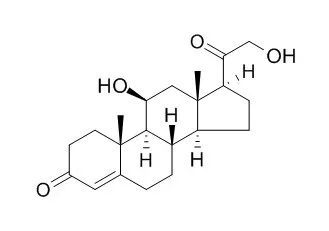| In vivo: |
| Gen Comp Endocrinol. 2015 Jan 1;210:38-45. | | Protracted treatment with corticosterone reduces breeding success in a long-lived bird.[Pubmed: 25449182] | Determining the physiological mechanisms underpinning life-history decisions is essential for understanding the constraints under which life-history strategies can evolve. In long-lived species, where the residual reproductive value of breeders is high, adult survival is a key contributor to lifetime reproductive success. We therefore expect that when adult survival is compromised during reproduction, mechanisms will evolve to redirect resources away from reproduction, with implications for reproductive hormones, adult body mass, nest attendance behaviour and breeding success.
METHODS AND RESULTS:
We investigated whether manipulating Corticosterone, to simulate exposure to an environmental stressor, affected the secretion of prolactin and breeding success in the black-legged kittiwake Rissa tridactyla. We used implanted Alzet® osmotic pumps to administer Corticosterone to incubating kittiwakes at a constant rate over a period of approximately 8days. Manipulated birds were compared with sham implanted birds and control birds, which had no implants. There was no significant difference in the body mass of captured individuals at the time of implantation and implant removal. Corticosterone-implanted males showed lower nest attendance during the chick rearing period compared to sham-implanted males; the opposite pattern was found in females. Corticosterone treated birds showed a marginally significant reduction in breeding success compared to sham-implanted individuals, with all failures occurring at least 1week after implant removal. However, prolactin concentrations at implant removal were not significantly different from initial values.
CONCLUSIONS:
We were unable to measure the profile of change in Corticosterone during the experiment. However, our results suggest a delayed effect of elevated Corticosterone on breeding success rather than an immediate suppression of prolactin concentrations causing premature failure. | | J Neurochem. 2015 Jun;133(5):708-21. | | Corticosterone primes the neuroinflammatory response to DFP in mice: potential animal model of Gulf War Illness.[Pubmed: 25753028] | Gulf War Illness (GWI) is a multi-symptom disorder with features characteristic of persistent sickness behavior. Among conditions encountered in the Gulf War (GW) theater were physiological stressors (e.g., heat/cold/physical activity/sleep deprivation), prophylactic treatment with the reversible AChE inhibitor, pyridostigmine bromide (PB), the insect repellent, N,N-diethyl-meta-toluamide (DEET), and potentially the nerve agent, sarin. Prior exposure to the anti-inflammatory glucocorticoid, Corticosterone (CORT), at levels associated with high physiological stress, can paradoxically prime the CNS to produce a robust proinflammatory response to neurotoxicants and systemic inflammation; such neuroinflammatory effects can be associated with sickness behavior.
METHODS AND RESULTS:
Here, we examined whether Corticosterone primed the CNS to mount neuroinflammatory responses to GW exposures as a potential model of GWI. Male C57BL/6 mice were treated with chronic (14 days) PB/ DEET, subchronic (7-14 days) Corticosterone, and acute exposure (day 15) to diisopropyl fluorophosphate (DFP), a sarin surrogate and irreversible AChE inhibitor. DFP alone caused marked brain-wide neuroinflammation assessed by qPCR of tumor necrosis factor-α, IL6, chemokine (C-C motif) ligand 2, IL-1β, leukemia inhibitory factor, and oncostatin M. Pre-treatment with high physiological levels of Corticosterone greatly augmented (up to 300-fold) the neuroinflammatory responses to DFP. Anti-inflammatory pre-treatment with minocycline suppressed many proinflammatory responses to Corticosterone+DFP. Our findings are suggestive of a possible critical, yet unrecognized interaction between the stressor/environment of the GW theater and agent exposure(s) unique to this war. Such exposures may in fact prime the CNS to amplify future neuroinflammatory responses to pathogens, injury, or toxicity. Such occurrences could potentially result in the prolonged episodes of sickness behavior observed in GWI.
CONCLUSIONS:
Gulf War (GW) veterans were exposed to stressors, prophylactic medicines and, potentially, nerve agents in theater. Subsequent development of GW Illness, a persistent multi-symptom disorder with features characteristic of sickness behavior, may be caused by priming of the CNS resulting in exaggerated neuroinflammatory responses to pathogens/insults. Nerve agent, diisopropyl fluorophosphate (DFP), produced a neuroinflammatory response that was exacerbated by pre-treatment with levels of Corticosterone simulating heightened stressor conditions. While prophylactic treatments reduced DFP-induced neuroinflammation, this effect was negated when those treatments were combined with Corticosterone. |
|






 Cell. 2018 Jan 11;172(1-2):249-261.e12. doi: 10.1016/j.cell.2017.12.019.IF=36.216(2019)
Cell. 2018 Jan 11;172(1-2):249-261.e12. doi: 10.1016/j.cell.2017.12.019.IF=36.216(2019) Cell Metab. 2020 Mar 3;31(3):534-548.e5. doi: 10.1016/j.cmet.2020.01.002.IF=22.415(2019)
Cell Metab. 2020 Mar 3;31(3):534-548.e5. doi: 10.1016/j.cmet.2020.01.002.IF=22.415(2019) Mol Cell. 2017 Nov 16;68(4):673-685.e6. doi: 10.1016/j.molcel.2017.10.022.IF=14.548(2019)
Mol Cell. 2017 Nov 16;68(4):673-685.e6. doi: 10.1016/j.molcel.2017.10.022.IF=14.548(2019)